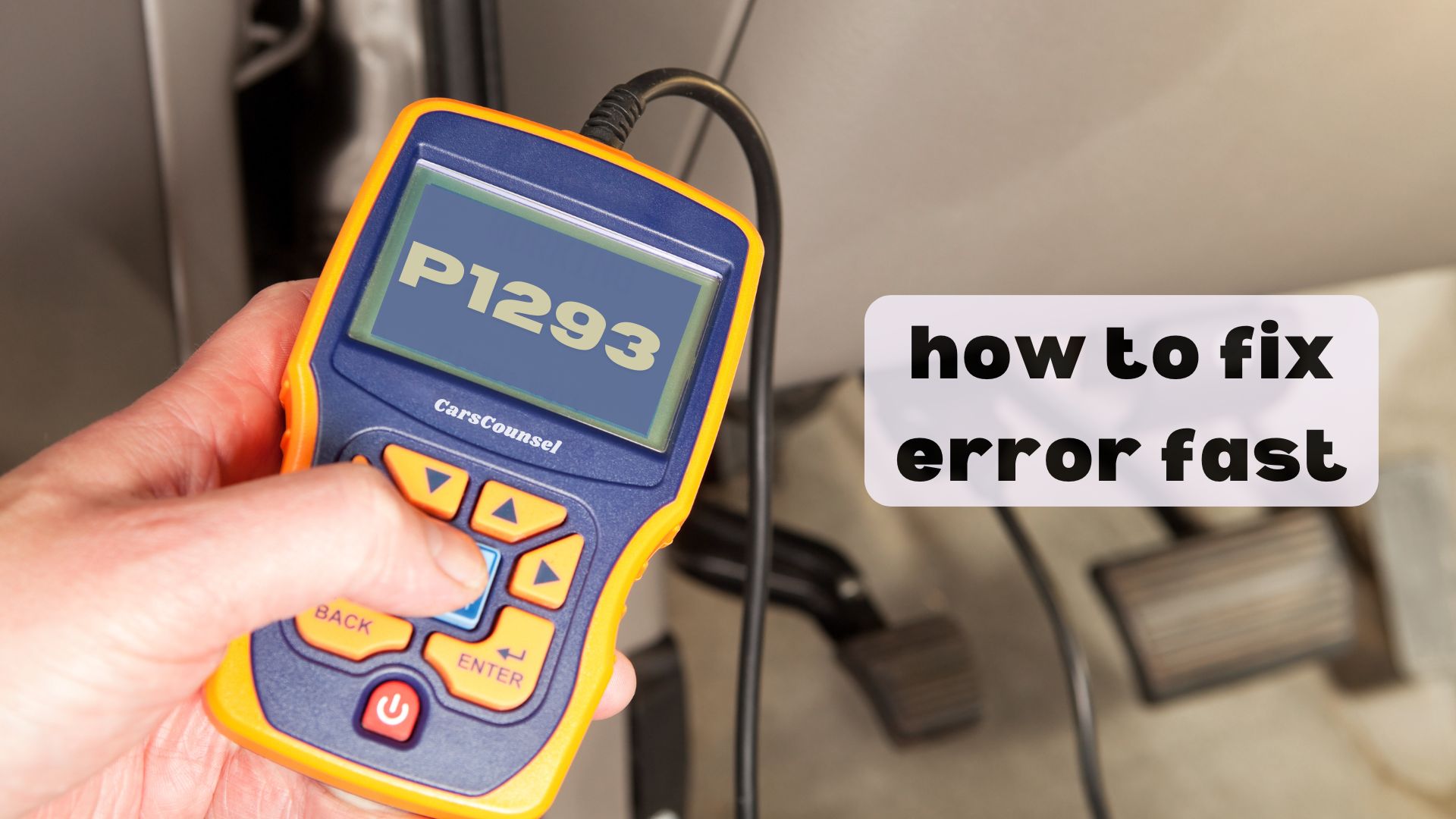Did you know that over 70% of modern vehicles rely on fuel injection systems to optimize performance? If your check engine light has come on, it may be due to a P1293 code, indicating a high side open condition on Bank No. 1 of your fuel injection system. This code can lead to poor engine performance, increased fuel consumption, and even engine damage if left unaddressed. As you examine the causes and symptoms of this code, you’ll want to take a closer look at your fuel system to identify the faulty component and prevent further damage.

Quick Navigation
Key Takeaways
- P1293 code indicates a high side open condition on Bank No. 1 of the fuel injection system, affecting engine performance and fuel consumption.
- Faulty high-pressure fuel pump, clogged fuel filter, or leaking fuel injector can cause the P1293 code, leading to poor engine performance and decreased fuel efficiency.
- Symptoms include engine misfires, rough idling, difficulty starting the engine, and the illuminated check engine light.
- Diagnosis involves using a scan tool to identify the root cause, inspecting and replacing faulty components, and checking wiring and connections.
- Ignoring the issue can lead to further engine damage and increased repair costs, so prompt repair is essential.
Code P1293 Description
When your vehicle’s onboard diagnostics system triggers a P1293 code, it’s indicating a high side open condition on Bank No. 1 of the fuel injection system.
This means there’s a problem with the high-pressure side of the fuel system, which could lead to issues with fuel delivery and combustion.
Fuel pump issues can cause poor engine performance, increased fuel consumption, and potential damage to engine components.
Engine diagnostics will help you identify the root cause of the problem.
The error code may trigger the check engine light to illuminate, so it’s essential to address the issue promptly to prevent further damage.
Common Causes of P1293
Several faulty components can trigger the P1293 code, and it’s essential to identify the root cause to guarantee a proper repair. You’ll need to investigate the high-pressure side of your fuel system to resolve issues with fuel pressure and efficiency.
| Component | Description | Impact on Fuel System |
|---|---|---|
| High-Pressure Fuel Pump | Faulty or malfunctioning | Reduced fuel pressure, affecting engine performance |
| Fuel Filter | Clogged or dirty | Restricted fuel flow, decreased fuel efficiency |
| Fuel Injector | Leaking or clogged | Uneven fuel distribution, poor engine performance |
| Wiring or Connections | Loose or damaged | Disrupted fuel system communication, faulty fuel pressure regulation |
Symptoms of P1293
Identifying the symptoms of a P1293 code is vital to understanding the impact it has on your vehicle’s performance.
You may notice engine misfires or rough idling, which can lead to decreased fuel economy and poor engine performance. Difficulty starting the engine, engine stalling, or hesitation during acceleration are also common symptoms.
If you’re experiencing any of these issues, it’s likely that your vehicle’s high-pressure fuel system is compromised. The check engine light may also illuminate, indicating a problem with the high side open condition on Bank No. 1 of your fuel injection system.
How to Fix P1293
To fix the P1293 code, you’ll need to diagnose the specific cause of the high side open condition using a scan tool, which will help you pinpoint the problem area in the fuel injection system.
This will enable you to identify the root cause of the issue, whether it’s a faulty high-pressure fuel pump, clogged fuel filter, or leaking fuel injector.
- Inspect and replace faulty components, such as the high-pressure fuel pump, fuel filter, or fuel injector, to restore proper fuel delivery and combustion.
- Check and repair wiring and connection issues in the fuel injection system to prevent misfires and poor engine performance.
- Clear the DTC and test drive the vehicle to verify the issue has been resolved, resulting in improved fuel efficiency and engine performance.
Diagnosing the High Side Open Condition
When diagnosing a high side open condition, you’ll need to use a scan tool to access the vehicle’s onboard diagnostics (OBD-II) system and retrieve trouble code P1293.
This code indicates a problem with the high-pressure side of the fuel system, which is responsible for pressurizing fuel before it’s injected into the engine cylinders.
Your scan tool will provide live data and freeze frame information to help you understand the conditions when the fault occurred.
Review the fuel system overview to understand how the high-pressure fuel pump, fuel filter, and fuel injectors work together to deliver fuel to the engine.
Inspecting Fuel System Components
You’ll need to visually inspect the fuel system components to identify any signs of damage, wear, or clogging that could be contributing to the high side open condition.
Check for signs of fuel leaks, corrosion, or blockages in the fuel lines, fuel filter, and fuel injectors. Guarantee the fuel pressure is within the recommended specifications.
- Look for cracks or damage in the fuel hoses and lines
- Inspect the fuel filter for clogging or contamination
- Check the fuel injectors for signs of wear or clogging
- Verify the fuel pressure sensor is functioning correctly
- Certify that there are no loose or corroded connections in the fuel system
Repairing or Replacing Faulty Parts
Faulty components in the fuel system must be repaired or replaced to resolve the high side open condition on Bank No. 1.
You’ll need to identify the faulty part and take action accordingly. If the high-pressure fuel pump is faulty, you’ll need to perform a Fuel Pump Replacement. Verify you follow the manufacturer’s guidelines for the replacement process.
Additionally, Sensor Calibration may be required to guarantee the engine is running efficiently. Replace any damaged or clogged fuel injectors, and inspect the fuel filter for any blockages.
Clearing the DTC and Testing the Vehicle
After replacing the faulty components, it’s essential to clear the P1293 DTC and test drive the vehicle to verify the high side open condition on Bank No. 1 has been resolved and confirm the repair is successful.
Clear the P1293 code and test drive to confirm the high side open condition on Bank No. 1 is resolved.
You’ll need to use a scan tool to clear the code and reset the vehicle’s onboard computer.
Follow these test drive protocols to validate the issue is resolved:
- Drive the vehicle for at least 10 miles to allow the fuel system to pressurize and stabilize.
- Monitor the vehicle’s performance, paying attention to any signs of misfires, rough idling, or decreased fuel efficiency.
- Use a scan tool to monitor live data and confirm the high side open condition is no longer present.
- Perform multiple test drives to guarantee the repair is consistent and reliable.
- Document your test drive results to maintain a record of the repair.
Additional Repair Information and Costs
One crucial aspect of addressing the P1293 code is understanding the financial implications of the repair.
You’ll want to factor in the cost of replacing faulty components, such as the high-pressure fuel pump or fuel injector, which can range from $200 to $800, including parts and labor.
Diagnosis time and labor rates at auto repair shops can vary, so it’s essential to get a clear estimate before proceeding.
Keep in mind that the specific cause of the issue and the make and model of your vehicle will influence the final cost.
Obtaining Quotes and Comparing Prices
When seeking quotes from multiple auto repair shops, it’s essential to provide them with the same information to guarantee precise estimates.
Provide consistent details to multiple shops for accurate estimates and a fair comparison.
This includes the P1293 code, symptoms, and any diagnostic results. Be prepared to answer questions about your vehicle’s make, model, and mileage.
- Clearly describe the issue and symptoms to each shop
- Ask about their experience with P1293 code repairs
- Inquire about the repair process and estimated timeframe
- Request a breakdown of the costs, including parts and labor
- Verify if they offer any warranties or guarantees
More OBD-II Codes
| P1294 | P1226 | P1209 | P1210 |
| P1204 | P1202 | P1203 | P1198 |
| P1146 | P1145 | P1144 | P1143 |
| P1142 | P1140 | P1139 | P1141 |
| P1138 | P1137 | P1222 | P1221 |
| P1214 | P1213 | P1212 | P1173 |
Frequently Asked Questions
Can a Faulty Oxygen Sensor Trigger a P1293 Code?
You’re wondering if a faulty oxygen sensor can trigger a P1293 code; however, it’s unlikely, as the oxygen sensor’s operation doesn’t directly affect the high-pressure fuel system’s malfunction, which is the primary cause of the P1293 code.
Will a P1293 Code Cause Engine Damage if Left Unchecked?
If you leave your engine unchecked, it’ll fundamentally become a ticking time bomb, prone to catastrophic engine wear and fuel inefficiency, as the compromised high-pressure fuel system wreaks havoc on your engine’s performance and longevity.
Can I Drive My Vehicle With a P1293 Code?
You can drive your vehicle with a P1293 code, but it’s not recommended as it can cause poor ignition timing, leading to engine misfires and decreased fuel efficiency, potentially damaging your fuel injector and other engine components.
Is a P1293 Code Specific to a Certain Type of Vehicle?
Like a puzzle piece, you’re wondering if a specific code fits only certain vehicles. The answer is no, a high side open condition can occur in various vehicles, including those with V6 engines and fuel injectors, making it a universal issue that requires attention.
Can a P1293 Code Be Triggered by Low Fuel Pressure?
You’re wondering if low fuel pressure can trigger a code, and the answer is yes, it can. A faulty fuel pump or clogged fuel filter can cause low pressure, leading to a high side open condition, which may set off the code.
Conclusion
You’ve navigated the troubleshooting waters, and now it’s time to set sail for smooth sailing. With a clear understanding of the P1293 code, you’re equipped to tackle the repair and get your engine purring like a well-fed cat. Remember, prompt attention is key to preventing further damage and costly repairs. By following these steps, you’ll be back on the road in no time, with a fuel injection system that’s firing on all cylinders.

